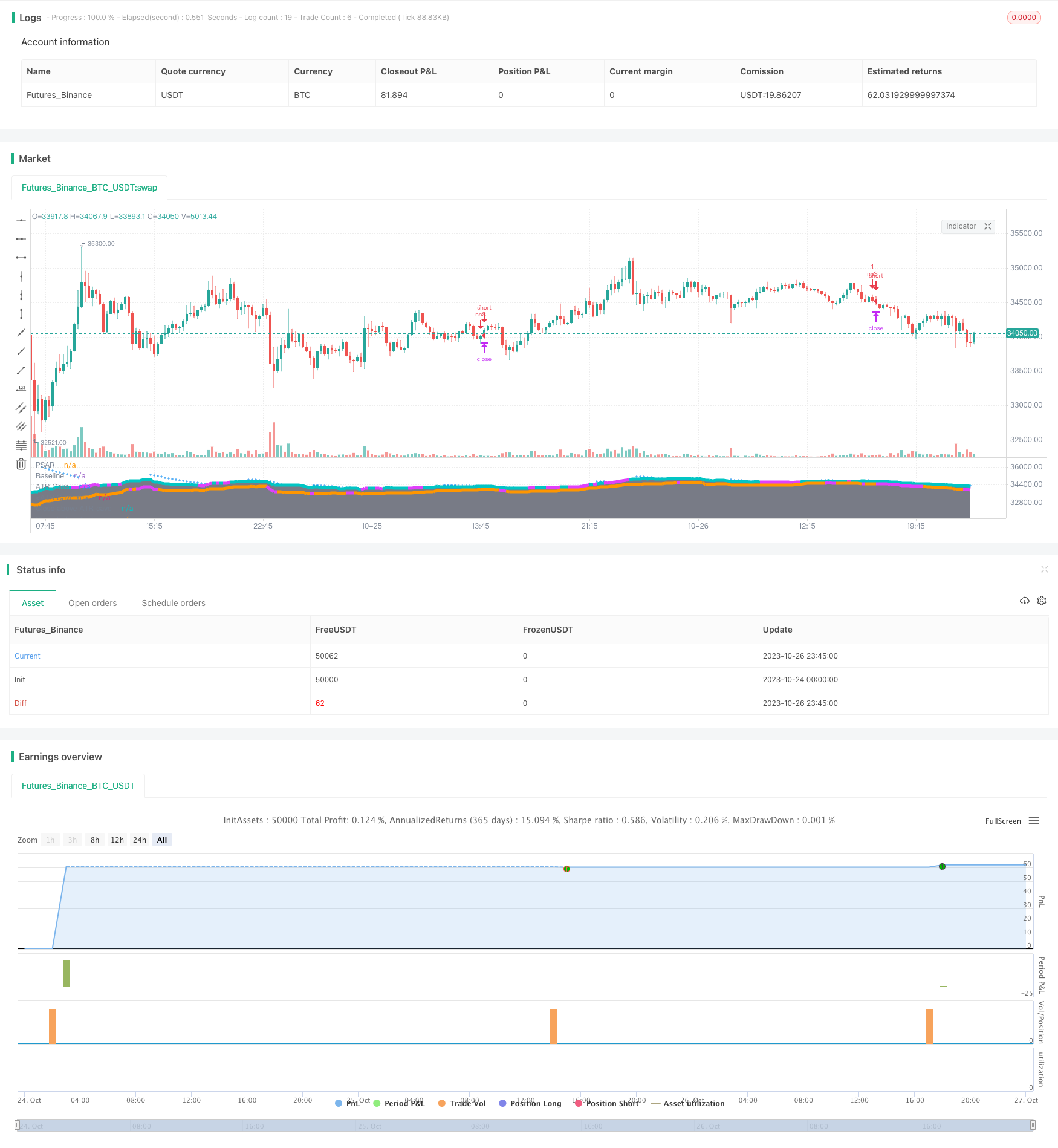
概述
双向ATR波浪交易策略是一种趋势跟踪策略,结合均线、ATR和多个技术指标,在趋势方向建立之后进行趋势跟踪交易。
策略原理
该策略使用Kijun线作为主要的均线指标,判断价格趋势方向。策略同时结合ATR通道,限制价格活动范围。当价格接近上轨时不做多,当价格接近下轨时不做空,避免追高杀跌。
当Kijun线发生向上突破时产生买入信号,当发生向下突破时产生卖出信号。为过滤误信号,策略还引入多个技术指标进行确认,包括Aroon指标、RSI指标、MACD指标和PSAR指标。满足所有指标的确认条件时,才生成买入和卖出信号。
入市后,策略采用止损和止盈方式管理仓位。止损点为0.5 ATR,止盈点为0.5%。当价格再次突破Kijun线反向时,选择立即止损退出。
策略优势
- 使用Kijun线判断趋势方向,避免被震荡市场套牢
- ATR通道限制价格活动范围,有利控制风险
- 多个技术指标确认,可大幅过滤误信号
- 结合止损止盈风险管理,有利锁定盈利
策略风险
- 多个指标确认造成信号延迟,可能错失趋势开始阶段
- 止损点过小可能频繁被止损出场
- Kijun线和ATR参数不合理可能导致频繁错误信号
- 依赖参数优化和历史数据拟合结果,实盘可能效果不佳
优化方向
- 尝试更先进的趋势判断指标,如Ichimoku云图等
- 调整止损止盈点,优化盈亏比
- 测试不同市场的最佳参数组合
- 增加自动调参功能,根据实时市场调整参数
- 测试不同Confirmation指标组合的效果
总结
双向ATR波浪交易策略综合使用均线、ATR通道以及多个辅助技术指标,在确定趋势方向后进行趋势跟踪操作。相比单一指标策略,可以大大提高信号质量和获利概率。同时止损止盈机制控制风险。通过参数优化和组合测试,该策略可望取得稳定的盈利。但需要注意过于依赖历史数据的问题,实盘效果仍需验证。持续优化是确保策略效果的关键。
策略源码
/*backtest
start: 2023-10-24 00:00:00
end: 2023-10-27 00:00:00
period: 15m
basePeriod: 5m
exchanges: [{"eid":"Futures_Binance","currency":"BTC_USDT"}]
*/
//@version=4
// strategy(title="NoNonsense Forex", overlay=true, default_qty_value=100000, initial_capital=100)
//////////////////////
////// BASELINE //////
//////////////////////
ma_slow_type = input(title="Baseline Type", type=input.string, defval="Kijun", options=["ALMA", "EMA", "DEMA", "TEMA", "WMA", "VWMA", "SMA", "SMMA", "HMA", "LSMA", "Kijun", "McGinley"])
ma_slow_src = close //input(title="MA Source", type=input.source, defval=close)
ma_slow_len = input(title="Baseline Length", type=input.integer, defval=20)
ma_slow_len_fast = input(title="Baseline Length Fast", type=input.integer, defval=12)
lsma_offset = input(defval=0, title="* Least Squares (LSMA) Only - Offset Value", minval=0)
alma_offset = input(defval=0.85, title="* Arnaud Legoux (ALMA) Only - Offset Value", minval=0, step=0.01)
alma_sigma = input(defval=6, title="* Arnaud Legoux (ALMA) Only - Sigma Value", minval=0)
ma(type, src, len) =>
float result = 0
if type=="SMA" // Simple
result := sma(src, len)
if type=="EMA" // Exponential
result := ema(src, len)
if type=="DEMA" // Double Exponential
e = ema(src, len)
result := 2 * e - ema(e, len)
if type=="TEMA" // Triple Exponential
e = ema(src, len)
result := 3 * (e - ema(e, len)) + ema(ema(e, len), len)
if type=="WMA" // Weighted
result := wma(src, len)
if type=="VWMA" // Volume Weighted
result := vwma(src, len)
if type=="SMMA" // Smoothed
w = wma(src, len)
result := na(w[1]) ? sma(src, len) : (w[1] * (len - 1) + src) / len
if type=="HMA" // Hull
result := wma(2 * wma(src, len / 2) - wma(src, len), round(sqrt(len)))
if type=="LSMA" // Least Squares
result := linreg(src, len, lsma_offset)
if type=="ALMA" // Arnaud Legoux
result := alma(src, len, alma_offset, alma_sigma)
if type=="Kijun" //Kijun-sen
kijun = avg(lowest(len), highest(len))
result :=kijun
if type=="McGinley"
mg = 0.0
mg := na(mg[1]) ? ema(src, len) : mg[1] + (src - mg[1]) / (len * pow(src/mg[1], 4))
result :=mg
result
baseline = ma(ma_slow_type, ma_slow_src, ma_slow_len)
plot(baseline, title='Baseline', color=rising(baseline,1) ? color.green : falling(baseline,1) ? color.maroon : na, linewidth=3)
//////////////////
////// ATR ///////
//////////////////
atrlength=input(14, title="ATR Length")
one_atr=rma(tr(true), atrlength)
upper_atr_band=baseline+one_atr
lower_atr_band=baseline-one_atr
plot(upper_atr_band, color=color.gray, style=plot.style_areabr, transp=95, histbase=50000, title='ATR Cave')
plot(lower_atr_band, color=color.gray, style=plot.style_areabr, transp=95, histbase=0, title='ATR Cave')
plot(upper_atr_band, color=close>upper_atr_band ? color.fuchsia : na, style=plot.style_line, linewidth=5, transp=50, title='Close above ATR cave')
plot(lower_atr_band, color=close<lower_atr_band ? color.fuchsia : na, style=plot.style_line, linewidth=5, transp=50, title='Close below ATR cave')
donttradeoutside_atrcave=input(true)
too_high = close>upper_atr_band and donttradeoutside_atrcave
too_low = close<lower_atr_band and donttradeoutside_atrcave
////////////////////////////
////// CONFIRMATION 1 ////// the trigger actually
////////////////////////////
lenaroon = input(8, minval=1, title="Length Aroon")
c1upper = 100 * (highestbars(high, lenaroon+1) + lenaroon)/lenaroon
c1lower = 100 * (lowestbars(low, lenaroon+1) + lenaroon)/lenaroon
c1CrossUp=crossover(c1upper,c1lower)
c1CrossDown=crossunder(c1upper,c1lower)
////////////////////////////////
////// CONFIRMATION: MACD //////
////////////////////////////////
dont_use_macd=input(false)
macd_fast_length = input(title="Fast Length", type=input.integer, defval=13)
macd_slow_length = input(title="Slow Length", type=input.integer, defval=26)
macd_signal_length = input(title="Signal Smoothing", type=input.integer, minval = 1, maxval = 50, defval = 9)
macd_fast_ma = ema(close, macd_fast_length)
macd_slow_ma = ema(close, macd_slow_length)
macd = macd_fast_ma - macd_slow_ma
macd_signal = ema(macd, macd_signal_length)
macd_hist = macd - macd_signal
macdLong=macd_hist>0 or dont_use_macd
macdShort=macd_hist<0 or dont_use_macd
/////////////////////////////
///// CONFIRMATION: RSI /////
/////////////////////////////
dont_use_rsi=input(false)
lenrsi = input(14, minval=1, title="RSI Length") //14
up = rma(max(change(close), 0), lenrsi)
down = rma(-min(change(close), 0), lenrsi)
rsi = down == 0 ? 100 : up == 0 ? 0 : 100 - (100 / (1 + up / down))
rsiLong=rsi>50 or dont_use_rsi
rsiShort=rsi<50 or dont_use_rsi
//////////////////////////////
///// CONFIRMATION: PSAR /////
//////////////////////////////
dont_use_psar=input(false)
psar_start = input(0.03, step=0.01)
psar_increment = input(0.018, step=0.001)
psar_maximum = input(0.11, step=0.01) //default 0.08
psar = sar(psar_start, psar_increment, psar_maximum)
plot(psar, style=plot.style_cross, color=color.blue, title='PSAR')
psarLong=close>psar or dont_use_psar
psarShort=close<psar or dont_use_psar
/////////////////////////
///// CONFIRMATIONS /////
/////////////////////////
Long_Confirmations=psarLong and rsiLong and macdLong
Short_Confirmations=psarShort and rsiShort and macdShort
GoLong=c1CrossUp and Long_Confirmations and not too_high
GoShort=c1CrossDown and Short_Confirmations and not too_low
////////////////////
///// STRATEGY /////
////////////////////
use_exit=input(false)
KillLong=c1CrossDown and use_exit
KillShort=c1CrossUp and use_exit
SL=input(0.5, step=0.1)/syminfo.mintick
TP=input(0.005, step=0.001)/syminfo.mintick
strategy.entry("nnL", strategy.long, when = GoLong)
strategy.entry("nnS", strategy.short, when = GoShort)
strategy.exit("XL-nn", from_entry = "nnL", loss = SL, profit=TP)
strategy.exit("XS-nn", from_entry = "nnS", loss = SL, profit=TP)
strategy.close("nnL", when = KillLong)
strategy.close("nnS", when = KillShort)